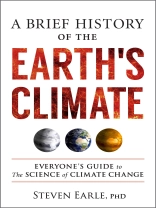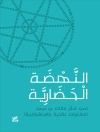I love it. Earle understands the big climate picture and paints it with exceptional clarity.
— JAMES HANSEN, director, Climate Science, Awareness and Solutions, Columbia University Earth Institute
What’s natural, what’s caused by humans, and why climate change is a disaster for all
A Brief History of the Earth’s Climate is an accessible myth-busting guide to the natural evolution of the Earth’s climate over 4.6 billion years, and how and why human-caused global warming and climate change is different and much more dangerous.
Richly illustrated chapters cover the major historical climate change processes including evolution of the sun, plate motions and continental collisions, volcanic eruptions, changes to major ocean currents, Earth’s orbital variations, sunspot variations, and short-term ocean current cycles. As well as recent human-induced climate change and an overview of the implications of the COVID pandemic for climate change. Content includes:
- Understanding natural geological processes that shaped the climate
- How human impacts are now rapidly changing the climate
- Tipping points and the unfolding climate crisis
- What we can do to limit the damage to the planet and ecosystems
- Countering climate myths peddled by climate change science deniers.
A Brief History of the Earth’s Climate is essential reading for everyone who is looking to understand what drives climate change, counter skeptics and deniers, and take action on the climate emergency.
AWARDS
- SILVER | 2022 IPPY Awards – Science
Mục lục
Preface
Acknowledgments
Introduction
1. What Controls the Earth’s Climate?
2. A Slowly Warming Sun
3. Sliding Plates and Colliding Continents
4. Cooling and Warming from Volcanic Eruptions
5. Earth’s Orbital Variations
6. Moving Heat with Ocean Currents
7. Short-term Solar Variations
8. Catastrophic Collisions
9. A Plague of Humans
10. Tipping Points
11. What Now?
Notes
Index
About the Author
About New Society Publishers
Giới thiệu về tác giả
Steven Earle, Ph D, has taught university Earth Science for almost four decades and is author of the widely used textbook, Physical Geology. He participates in climate change research and community engagement with climate change solutions in the areas of transport and land stewardship on Gabriola Island, Canada, where he lives with his family.












